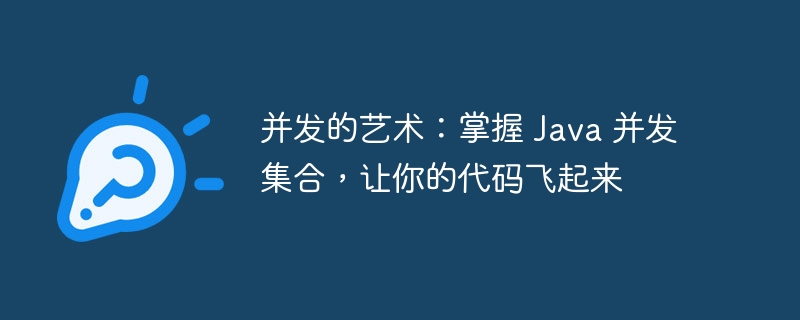
php editor Baicao discovered that mastering Java concurrent collections will make your code fly! Java concurrent collections are an important part of Java programming, which provide methods to safely operate data structures in a multi-threaded environment. By learning and mastering Java concurrent collections, you can handle various problems in concurrent programming more efficiently and improve program performance and reliability. Let's delve into Java concurrent collections together, discover the secrets and techniques, and help you become a better Java programmer!
-
ConcurrentHashMap: A threaded safe hash table that can efficiently store and retrieve key-value pairs.
-
ConcurrentLinkedQueue: A thread-safe bidirectional queue that supports first-in, first-out (FIFO) operations.
-
CopyOnWriteArrayList: A thread-safe list that only allows copy-on-write, which will not cause concurrency modification problems when traversing.
-
BlockingQueue: A queue that supports blocking operations. When the queue is empty, the thread will block until an element is available.
Advantages of using concurrent collections
-
Data consistency: ConcurrencyCollection Provides synchronous access to shared data to prevent thread conflicts and data corruption.
-
Performance optimization: Concurrent collections have been optimized and can efficiently handle concurrent operations in a multi-threaded environment.
-
Simplify development: Using concurrent collections can simplify multi-threaded programming, without the need to manually implement the synchronization mechanism.
Notes on using concurrent collections
-
Deadlock: When using concurrent collections, you need to be careful to avoid deadlocklock, that is, two or more threads wait for each other to release the lock.
-
Performance overhead: The synchronization mechanism of concurrent collections will bring certain performance overhead and should not be used when concurrent operations are not required.
-
Choose the appropriate collection: Choose the appropriate concurrent collection according to specific needs. Different collections have different characteristics and applicable scenarios.
Best Practices
-
Use lock-free collections: If possible, try to use lock-free concurrent collections, such as ConcurrentHashMap, they can provide better performance.
-
Limit concurrent access: Restrict concurrent access to shared data through locks or atomic operations to avoid excessive competition.
-
Use copies: When you need to modify shared data frequently, you can consider using copies instead of directly modifying the original data.
-
Monitor concurrent behavior: Use tools or log record Monitor concurrent behavior to discover potential problems in a timely manner.
Mastering the skills of concurrent collections
-
Understand the implementation of concurrent collections: Be familiar with the internal mechanism of concurrent collections and understand the synchronization mechanism and data structure they provide.
-
Master the basics of concurrent programming: Be familiar with Concurrent programming concepts, such as thread safety, locks and atomic operations.
-
Practical exercises: Practice and deepen your understanding by writing multi-threaded programs and using concurrent collections.
-
Reference documentation and tutorials: Check the official documentation and tutorials to learn the detailed usage and best practices of concurrent collections.
The above is the detailed content of The Art of Concurrency: Master Java Concurrency Collections and Make Your Code Fly. For more information, please follow other related articles on the PHP Chinese website!


 How to get the input number in java
How to get the input number in java
 How to open nrg file
How to open nrg file
 Bitcoin historical price chart
Bitcoin historical price chart
 How to deduplicate database in mysql
How to deduplicate database in mysql
 There are several output and input functions in C language
There are several output and input functions in C language
 Google earth cannot connect to the server solution
Google earth cannot connect to the server solution
 How to repair sql database
How to repair sql database
 What are the seven principles of PHP code specifications?
What are the seven principles of PHP code specifications?
 How to execute a shell script
How to execute a shell script




